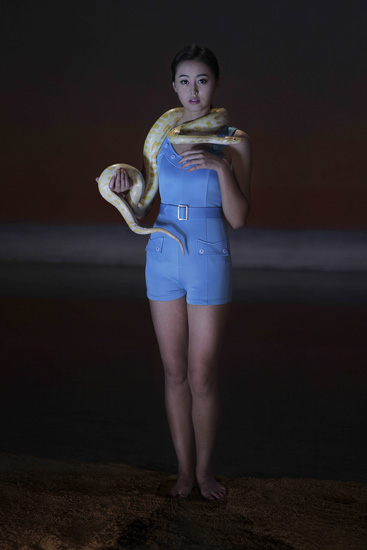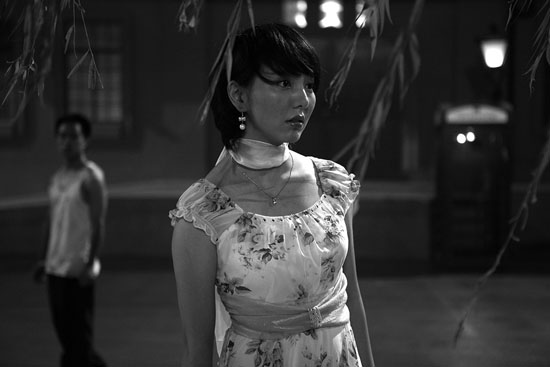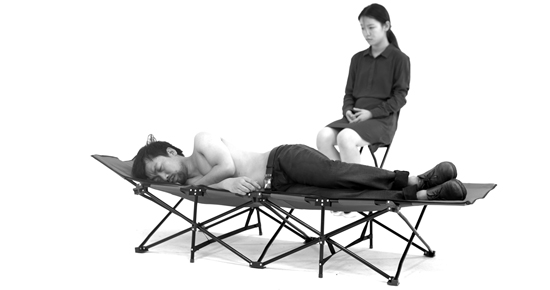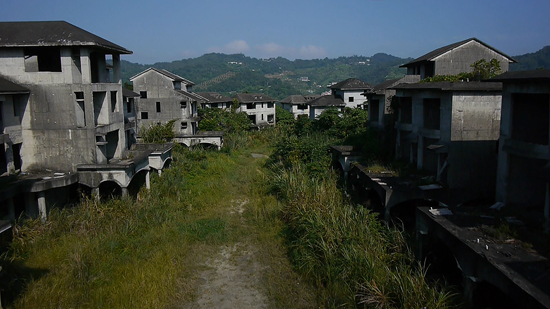Luise Guest on the work of Yang Fudong at Yuz Museum, Tao Hui at UCCA and Yuan Goang-ming at Hanart TZ…
The photographic image (still and moving) has a complex and contested history in China. An import from the west during times of colonial control, photography was initially resisted, and then enthusiastically embraced. The photographic process itself dates from the same year the First Opium War erupted, in 1839, and China’s defeat and humiliation after the Treaty of Nanking was recorded in the brand new ‘calotype’ process. By the end of the 19th century and into the 20th, busy photographic studios recorded life in China, making portraits of the elevated and the humble alike, and the influence of Modernist photography was evident, especially in Shanghai. Film, likewise, exploded in popularity, and Shanghai movie studios rivalled Hollywood in the spectacular productions of the 1930s.
YUAN GOANG-MING Dwelling – Moment III 2014. Digital Photography / Colour Photograph. 120 x 180 cm Edition of 8. Image Courtesy of the Artist and Hanart TZ Gallery.
After the establishment of the Peoples Republic in 1949, Mao Zedong understood the power of film and photography as instruments of state control. For the next thirty years, constructed photographs and ‘documentary’ film were essential elements of his political machinery. It is from this uneasy history that contemporary artists emerging into a new China at the end of the 20th century and the start of the 21st had to extricate themselves. After Mao’s death, the opening of China to the outside world provided new influences, and the influx of popular culture from diverse sources created an experimental laboratory for the Chinese avant-garde.
Three recent exhibitions – in Shanghai, Beijing and Hong Kong – illustrate the rich diversity of contemporary practice in video and new media. Trained as a painter at the China Academy of Fine Art in Hangzhou, Yang Fudong says that the still and video camera have become his paint brushes. An iconic and influential figure in Chinese new media, rising to prominence in the first decade of this century, he expresses the feelings of his generation, caught between traditional Chinese culture and a new society of consumerism and instant gratification. Best known for Seven Intellectuals in a Bamboo Forest, a five-hour allegorical film cycle based on a third-century fable that explores the alienation of contemporary life (shown last December at the Australian Centre for the Moving Image (ACMI) in Melbourne) his works are lyrically beautiful, painterly and mysterious.
The exhibition of his work at one of China’s new privately funded art institutions, Shanghai’s Yuz Museum on the West Bund, is entitled ‘Twin Tracks’, a reference to a Chinese proverb: “Go south by driving the chariot north” is a paradox appropriate to Yang’s multi-layered and often deliberately ambiguous video works. On the day I visited, hundreds of people were patiently waiting in roped off lines to enter the ‘Rain Room’; far fewer seemed to have the patience to watch Yang’s languidly unfolding multi-screen narratives. Five important works are presented: East of Que Village (2007), Blue· Kylin/A Journal of Shan Dong (2008), The Fifth Night (2010), About the Unknown Girl – Ma Sise (2013-2015) and The Coloured Sky: New Women II (2014), a work commissioned by ACMI and the Auckland Art Gallery Toi o Tamaki.
Yang Fudong, The Coloured Sky: New Women II 2014. Video Installation. Image courtesy the artist and Yuz Museum
A departure from his characteristic use of moody black-and-white, the highly saturated colour of the five channel video work, The Coloured Sky: New Women II, emphasises the surreal nature of an artificial landscape, shot with stage lights on a movie set. A trio of young and beautiful girls, wearing 1940s swimsuits, move gracefully through scenery representing a deliberately unconvincing beach, the watery surroundings symbolising the emergent sexuality of the young women. Lurid sunsets, crashing waves, squalls of rain and threatening storms (and I must admit the knowledge that ‘clouds and rain’ is a metaphor for sexual intercourse in Chinese tradition did cross my mind) all create a somewhat fevered atmosphere of fervent longing and erotic imagination. An invitation to voyeurism? Perhaps, but Yang Fudong’s protagonists are self-possessed and self-contained, as they handle objects laden with symbolism, such as shells (evoking the birth of Venus) and snakes (no prizes for interpreting that one.) A real horse and a fake deer add to the weird artifice of the mise-en-scene. On the brink of adulthood, in that liminal zone between childhood and the grown-up world, the three girls can also be read as a symbol of China’s position, teetering between three points on a moral compass: the distant past of imperial China, the more recent revolutionary past, and the confronting contemporary world, with all its hyped-up manifestations of desire.
Yang Fudong, The Fifth Night 2010. Video Installation. Image Courtesy the artist and Yuz Museum
The following week, in Beijing, at the Ullens Center for Contemporary Art, I saw the work of young artist Tao Hui. His surreal juxtapositions and strange narrative arcs reflect the strong thread of magical realism in Chinese literature, past and present. As a small boy, Tao spent some years in a remote Sichuan mountain village, immersed in folklore and the impossible tales told by his neighbours. The disquieting atmosphere of his work reflects the strangeness of contemporary Chinese life. Savagery and sweetness; violence and beauty; past and present: all collide in a theatrical catharsis.
Tao Hui explores the emotional fall-out of people dealing with life in a society on fast-forward. All certainty has fled, and his generation are making up their own lives, a narrative without a script. Excessive is a surreal tale of conflict: a young girl’s extra finger causes grief to her family, so she cuts it off with a kitchen knife and burns it. A vitrine nearby contains the ashes of the incinerated finger, with an image of flames as a back projection – a theatrical device that projects the cinematic narrative into the physical space occupied by the audience. The Acting Tutorial presents amateur actors shot in an abandoned building, rehearsing extreme scenarios that conclude with them setting fire to one of their comrades. Traumatic and violent, it evokes the psychological scarring caused by the outpouring of collective madness during the Cultural Revolution, not yet healed over. Tao Hui asks us to consider what is real, what is truth.
Tao Hui, Excessive, 2015. Single-channel video installation, HD video, colour, sound, glass projector, silica gel, iron, wood, 112 x 59.8 x 30 cm; 19:32. Courtesy of the Artist.
1 Character and 7 Materials is immersive and compelling. Headphones provide both English and Chinese versions of the narrator’s toneless monologue, as she recounts a story of fleeing from a small village after a doomed love affair with her music student, the resulting unhappy marriage, the birth of a child, and the inevitable concluding tragedy on the banks of the Yangtze River. The imagery is beautiful yet surreal, including the appearance of ghosts, and an Immortal who steers his small boat across the vast waters of the Yangtze, white beard flying in the wind. We are left with the sense that the everyday world is a very thin carapace that does not quite conceal the world of myth, dreams and the imagination.
Finally, in Hong Kong, an exhibition of recent work by acclaimed Taiwanese artist and video pioneer Yuan Goang-ming, at Hanart TZ. In this show, entitled Dwelling, we are once again faced with the uncomfortable intersection of the real and the apparently impossible. In the gallery space, an elegant table is laid as if for a dinner party, with crystal glasses and an ornate dinner service. Every now and then a loud clanking noise disrupts the silence, and the table shakes as if the building has been hit by an earthquake. The real sense of disquiet comes when you enter the next room, where three short videos are screened on a loop. You sit on a domestic sofa, lit dimly by a standard lamp, and reality begins to unravel entirely. In the title work, Dwelling, (2014) the focus is a blandly modern living room, the only oddity the rather slow riffling pages of a magazine on the chair, a book on the coffee table. A breeze wafts the curtains. Suddenly, and without warning, the entire room explodes. Slowly, languidly, the wreckage of the room drifts back until the room once again regains its ordinary appearance. Filmed underwater, although it takes one a while to realise this, the movement of every object seems dreamlike. Yuan suggests that what we accept as stable and fixed is in fact entirely unpredictable. In a split second, the apparently impossible can disrupt everything we take for granted. Of course, we know this is true, but it is profoundly disturbing to see.
YUAN GOANG-MING, Landscape of Energy 2014. Single-Channel Video. 5’00” Edition of 5 + 2 AP. Image Courtesy the artist and Hanart TZ Gallery
The 561st Hour of Occupation (2014), documents the 2014 occupation of Taiwan’s legislative chamber by the Sunflower Student Movement. The camera pans over a jumble of bags, posters, and food containers left behind by the departing protestors, under a large portrait of Sun Yat-sen. The mood is reflective, sombre, an elegy rather than a celebration. Showing in Hong Kong, a year after Occupy Central and the Umbrella Movement, it suggests the failure of populist uprisings to change anything fundamental. A high perspective creates emotional distance, and a sense of alienation.
Using drones to achieve long, slow aerial takes, his camera floats over the Taiwanese coastland in Landscape of Energy (2014), panning across the ocean and towards an eerily deserted playing field and beach. The domes of a nuclear power plant in the distance suggest the possibility of catastrophe, people on the beach in the foreground seemingly oblivious. In the last segment of this work, the camera drifts towards an abandoned village, the jungle growing back over the houses, softening its edges and reminding us that, like Shelley’s Ozymandias, we too can become as nothing; power stations and tall cities crumbling into the ‘lone and level sands’ of desert, or hidden beneath reclaiming vegetation.
![Image 1 [Digital Photography_Colour Photograph] Dwelling - Moment III small file](http://theartlife.com.au/wp-content/uploads/2015/11/Image-1-Digital-Photography_Colour-Photograph-Dwelling-Moment-III-small-file.jpg)




